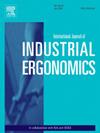Ergonomic design of mastectomy bra based on emotion measurements
IF 2.5
2区 工程技术
Q2 ENGINEERING, INDUSTRIAL
International Journal of Industrial Ergonomics
Pub Date : 2024-11-01
DOI:10.1016/j.ergon.2024.103659
引用次数: 0
Abstract
The mastectomy bra (M-bra) serves as an essential rehabilitative product for individuals who have undergone breast cancer surgery. This study aimed to develop an ergonomic design method for M-bras that addresses both the physiological and psychological needs of post-mastectomy breast cancer patients. Over 270 M-bras with diverse design options were collected from online markets, and more than 100 post-mastectomy patients participated in an online survey to rank their preferences regarding eight M-bra components and 19 design options. An orthogonal experimental design was applied to reduce the vast array of design combinations to 20 M-bra test samples. The Pleasure-Arousal-Dominance (PAD) emotion model and the Self-Assessment Manikin (SAM) scale were then used to collect PAD scores from 40 patients evaluating these test samples. Extreme difference analysis was conducted to evaluate the significance of the M-bra components and identify combinations that generated the highest and lowest PAD levels. Based on the PAD scores, 11 samples were categorized as "delighted" or "relaxed" M-bras due to their positive emotional polarity. Linear regression analysis showed strong correlations between the design options and PAD scores, with R2 values of 0.962 for P, 0.819 for A, and 0.949 for D. A backpropagation neural network was developed to predict PAD values for various M-bra design options, achieving prediction errors of 8.06% for P, 6.15% for A, and 13.29% for D, demonstrating satisfactory performance given the subjective nature of the evaluations.
基于情绪测量的乳房切除胸罩人体工学设计
乳房切除术胸罩(M-bra)是乳腺癌术后患者必不可少的康复产品。本研究旨在开发一种符合人体工程学的胸罩设计方法,以满足乳腺癌切除术后患者的生理和心理需求。研究人员从网上市场收集了 270 多种不同设计方案的 M 型胸罩,并对 100 多名乳腺癌术后患者进行了在线调查,以了解他们对 8 种 M 型胸罩组件和 19 种设计方案的偏好程度。采用正交实验设计将大量设计组合减少到 20 个 M-bra 测试样本。然后使用愉悦-烦恼-主导(PAD)情绪模型和自评量表(SAM)收集了 40 名患者对这些测试样本的 PAD 评分。通过极差分析来评估 M-bra 成分的重要性,并确定产生最高和最低 PAD 水平的组合。根据 PAD 分数,11 个样本因其积极的情绪极性而被归类为 "愉悦 "或 "放松 "M-bra。线性回归分析表明,设计方案与 PAD 分数之间具有很强的相关性,P 的 R2 值为 0.962,A 为 0.819,D 为 0.949。我们开发了一个反向传播神经网络来预测各种 M-bra 设计方案的 PAD 值,P 的预测误差为 8.06%,A 的预测误差为 6.15%,D 的预测误差为 13.29%,考虑到评价的主观性,其表现令人满意。
本文章由计算机程序翻译,如有差异,请以英文原文为准。
求助全文
约1分钟内获得全文
求助全文
来源期刊
CiteScore
6.40
自引率
12.90%
发文量
110
审稿时长
56 days
期刊介绍:
The journal publishes original contributions that add to our understanding of the role of humans in today systems and the interactions thereof with various system components. The journal typically covers the following areas: industrial and occupational ergonomics, design of systems, tools and equipment, human performance measurement and modeling, human productivity, humans in technologically complex systems, and safety. The focus of the articles includes basic theoretical advances, applications, case studies, new methodologies and procedures; and empirical studies.

 求助内容:
求助内容: 应助结果提醒方式:
应助结果提醒方式:


